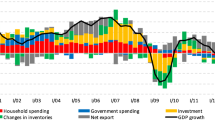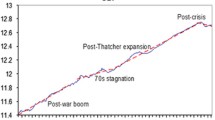Abstract
This paper explores the existence of the J-curve effect in Turkish services. The model of Bahmani-Oskooee (Rev Econ Stat 67:500–504, 1985), one of the most commonly employed model in the j-curve literature, is adopted. Using quarterly data from 1986: I to 1998: III, we find that, as a result of real depreciation of Turkish currency, YTL, services trade balance initially improves, then worsens and improves again in the short run. This is a pattern indicating that J-curve effect does not exist in Turkish services sector. We also find that depreciation of Turkish Lira improves the trade balance of the sector in the long run, a result consistent with earlier findings for the whole Turkish economy.
Similar content being viewed by others
References
Akbostanci E.: Dynamics of trade balance: the Turkish J-curve. Emerg. Mark. Finance Trade 40, 57–73 (2004)
Almon S.: The distributed lag between capital appropriations and expenditures. Econometrica 33, 178–196 (1965)
Bahmani-Oskooee M.: Devaluation and the J-curve: some evidence from LDCs. Rev. Econ. Stat. 67, 500–504 (1985)
Bahmani-Oskooee M.: Devaluation and the J-curve: some evidence from LDCs: Errata. Rev. Econ. Stat. 71, 553–554 (1989)
Bahmani-Oskooee M., Malixi M.: More evidence on the J-curve from LDCs. J. Policy Model. 14, 641–653 (1992)
Bahmani-Oskooee M., Ratha A.: The J-curve: a literature review. Appl. Econ. 36, 1377–1398 (2004a)
Bahmani-Oskooee M., Ratha A.: The J-curve dynamics of US bilateral trade. J. Econ. Finance 28, 32–38 (2004b)
Brada J.C., Kutan A.M., Zhou S.: The exchange rate and the balance of trade: the Turkish experience. J. Dev. Stud. 33, 675–692 (1997)
Carter C.A., Pick D.H.: The J-curve effect and the US agricultural trade policy. Am. J. Agric. Econ. 71, 712–720 (1989)
Dorodian K., Jung C., Boyd R.: The J-curve effect and US agricultural and industrial trade. Appl. Econ. 31, 687–690 (1999)
Kuruger, A.D.: Exchange Rate Determination. Cambridge University Press, Cambridge (1983).
Lal A.K., Lowinger T.C.: The J-curve: evidence from East Asia. J. Econ. Integr. 17, 397–415 (2002)
Magee S.P.: Currency contracts, pass-through, and devaluation. Brook. Papers Econ. Act. 1, 303–325 (1973)
Meade, E.E.: Exchange Rates, Adjustment, and the J-curve. Fed. Reserve Bull. 633–644 (1988).
Miles M.A.: The effects of devaluation on the trade balance and the balance of payments: some new results. J. Polit. Econ. 87, 600–620 (1979)
Noland M.: Japanese trade elasticities and J-curve. Rev. Econ. Stat. 71, 175–179 (1989)
Rose A.K.: Exchange rates and trade balance: some evidence from developing countries. Econ. Lett. 34, 271–275 (1990)
Author information
Authors and Affiliations
Corresponding author
Rights and permissions
About this article
Cite this article
Yazici, M. Is there a J-curve effect in Turkish services?. Qual Quant 44, 167–172 (2010). https://doi.org/10.1007/s11135-009-9268-1
Published:
Issue Date:
DOI: https://doi.org/10.1007/s11135-009-9268-1




